Physical Address
304 North Cardinal St.
Dorchester Center, MA 02124
Vascular tumors of bone are defined as a neoplastic proliferation of endothelial cells that are biologically benign or malignant. This is a heterogeneous group of tumors; it includes a wide variety of different clinicopathologic entities whose biological potential ranges from those that are relatively indolent and slow growing to those that are extremely aggressive and frequently fatal. Clinically significant vascular tumors are infrequent and account for a small fraction of primary bone tumors.
Vascular tumors are one of the more common neoplasms of the skeleton, and benign variants greatly outnumber their malignant counterparts. Careful autopsy studies have shown that hemangiomas of vertebral bodies are present in 10% of the population, and magnetic resonance imaging (MRI) investigations have identified them in 27% of imaged patients. The majority of lesions are discovered incidentally, and many are multicentric; multiple tumors are identified in 33% of patients with spinal hemangiomas. Vascular tumors may be a component of different syndromes, including posterior fossa malformations–hemangiomas–arterial anomalies–cardiac defects–eye abnormalities–sternal cleft and supraumbilical raphe (PHACE), Klippel-Trenaunay, and Sturge-Weber syndromes. However, in these settings, the vascular lesions usually affect the soft tissues and are not osseous in origin.
Vascular tumors of the skeleton can arise in any age group, and in any bone, but the majority develop in adults and affect the vertebral column, followed by the craniofacial and long bones. The clinical presentations are influenced by the tumors' location and size. Generally, they are asymptomatic. When symptomatic, they produce pain, swelling, and sometimes a pathologic fracture. Imaging studies help define their precise location, size, extent, and multifocality. In addition, these studies provide valuable information regarding the degree of destruction of the underlying bone. Radiographically, vascular tumors are lucent but can elicit varying degrees of reactive sclerosis that sometimes can be extensive.
The classification of vascular tumors of bone continues to evolve as the understanding of their biology increases and new entities are codified ( Box 13-1 ). Controversy persists in defining many benign vascular tumors as malformations or neoplasms, and the scheme utilized in this chapter is based on their biological behavior (benign versus malignant), extent of disease, and morphologic characteristics. The vast majority of tumors are considered to be neoplastic.
Arteriovenous malformation
Conventional hemangioma
Capillary
Cavernous
Venous
Mixed
Lymphangioma
Angiomatosis
Cystic angiomatosis
Lymphangiomatosis (Gorham Stout disease)
Epithelioid hemangioma
Kaposiform hemangioendothelioma
Epithelioid hemangioendothelioma
Pseudomyogenic hemangioendothelioma
Kaposi sarcoma
Angiosarcoma
Vascular malformations and anomalies of bone are rare. The lesions usually present at birth or during infancy and early childhood. In many patients, the bone and adjacent soft tissues are affected, and in severe cases large portions of an extremity are involved, resulting in significant morbidity. Presenting signs and symptoms include pain, a pulsating mass, bruit, overgrowth of an involved anatomic region, osteolytic lesions, arteriovenous shunting producing heart failure, and visible abnormal cartographic vascular patterns in the skin. Arteriovenous malformations often affect the extremities, especially the femur, tibia, radius, and humerus, jaw bones, and spine. Multiple bones are involved in a little more than one third of cases. Treatment depends on the extent of disease and may consist of embolization and surgery.
Radiographically, the lesion can present as multiple tubular and oval lucencies in the bone. The soft tissues contain abnormal tangles of large and small vessels, often associated with increased amounts of adipose tissue.
Gross specimens show irregular large vessels with prominent walls that course through the cortices and medullary cavity of the involved bones ( Fig. 13-1 ). Histologically, large, architecturally abnormal arteries, veins, and collections of capillaries course throughout the bone and adjacent soft tissues ( Fig. 13-2 ). The veins and capillaries may show organizing thrombi with phleboliths and papillary endothelial hyperplasia.

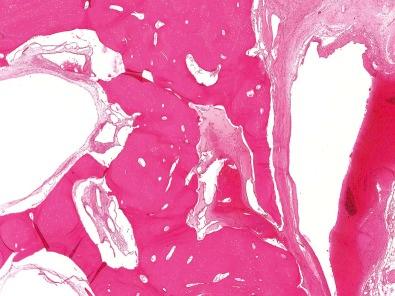
Conventional hemangioma is a benign vasoformative neoplasm of endothelial cells. It is the most common type of vascular tumor of the skeleton. The vast majority of cases are asymptomatic, and those that require surgical intervention are uncommon and account for less than 1% of all bone neoplasms requiring surgery.
The morphology of hemangiomas of bone is similar to those neoplasms that arise in soft tissues and skin, and most are classified as capillary, cavernous, venous, or mixed. The cavernous variant is the most common, constituting approximately 50% of all cases, followed by capillary hemangioma, which accounts for about 10% of cases. The tumors are usually centered in the medullary cavity and rarely are intracortical or subperiosteal in location.
Intraosseous hemangiomas are encountered most commonly in vertebrae followed by the bones of the skull (frontal and parietal bones), face, and the long bones of the extremities. The age range of affected patients is broad, but most are middle-aged adults (fifth decade). Rarely do these tumors develop in children. Males are affected almost twice as often as females. Most hemangiomas are detected as an incidental finding, and when clinically significant the tumors can present as a masslike deformity, causing localized pain or neurologic symptoms when compressing nerve roots or the spinal cord. In a minority of cases, a pathologic fracture is the heralding event.
Hemangioma manifests as an oval, radiolucent lesion with a trabeculated pattern. In the vertebral bodies, the vertically oriented bony trabeculae are thickened, giving the lesion a “corduroy” appearance ( Fig. 13-3 ). In the craniofacial skeleton, the tumors may evoke a prominent sclerotic reaction that can have a starburst or spoke wheel–like appearance ( Fig. 13-4 ). In the long bones and the pelvis, the tumors are irregular in shape and have a lytic, honeycomb pattern ( Fig. 13-5A and B ). Bone expansion is a feature of larger lesions, and locally aggressive tumors may erode the cortex and extend into the soft tissues. On computed tomography (CT), the tumor has the density of soft tissue and sclerotic bony trabeculae, which produce a polka-dot appearance on axial images. MRI is the best modality to demonstrate the extent of the tumor, impingement on other structures, and extension into the soft tissues ( Fig. 13-6 ). MRI shows that fat-rich hemangiomas have high signal intensity on T1-weighted images and that fat-poor lesions have intermediate or low signal intensities. The fluid in hemangiomas causes them to have high signal intensity on T2-weighted images.
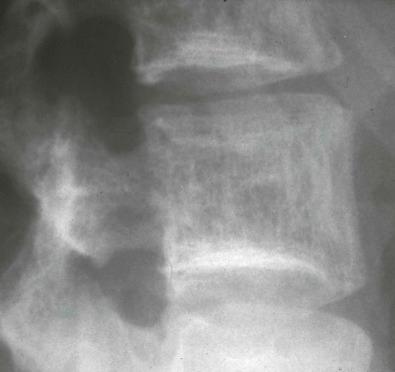
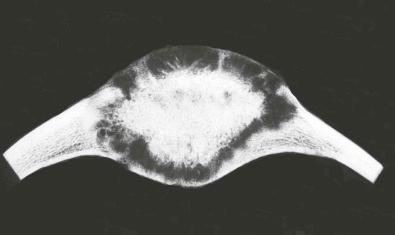
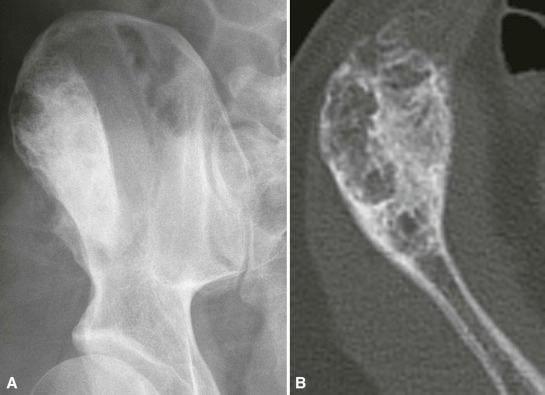
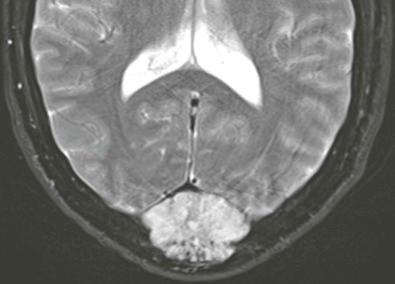
The tumors are centered in the medullary canal, and they distort the bone to varying degrees, depending on their size and associated reactive changes. Grossly, they present as red, hemorrhagic, spongy masses that vary in consistency ( Fig. 13-7 ). Lesions rich in reactive bone are gritty, with thin, radiating trabeculae subcompartmentalizing the tumor; in contrast, those that lack bone are soft and friable. Curettage specimens can appear as fragments of blood clot admixed with spicules of bone.
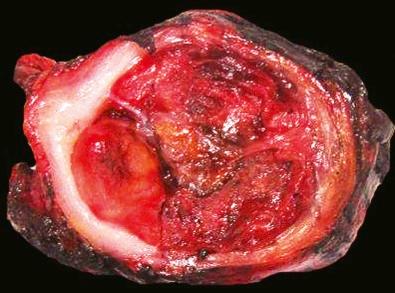
Hemangioma often has a lobular architecture with tumor vessels coursing through the marrow spaces, encasing preexisting bony trabeculae ( Fig. 13-8 ). Conventional hemangiomas are composed of blood vessels lined by flattened, cytologically bland endothelial cells ( Fig. 13-9 ). The vessels usually have thin walls. Those tumors composed of round, dilated capillaries are classified as cavernous hemangiomas, whereas those consisting of small diameter capillaries are the capillary variant. Tumors composed of veinlike structures are known as venous hemangiomas; however, some consider these lesions to be variants of vascular malformations rather than true neoplasms. It is not uncommon for tumors to have overlapping histologic features. In some cases, the vessels consist merely of an endothelial layer overlying reactive or preexisting trabecular bone ( Fig. 13-10 ), which makes their recognition challenging, especially in curettage specimens.
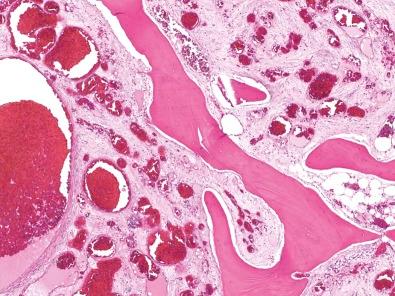
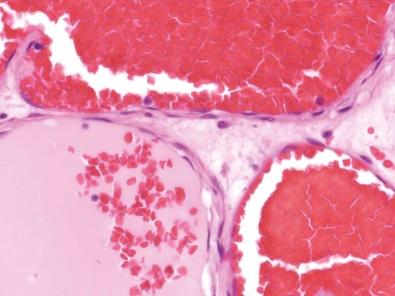
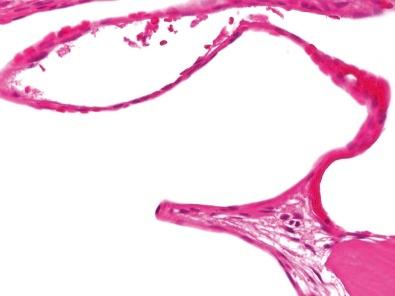
Secondary changes may develop and these include organizing thrombosis with the formation of calcified phleboliths and papillary endothelial hyperplasia. These changes most commonly accompany tumors with a prominent venous component.
Immunohistochemically, the endothelial cells express CD31, CD34, ERG, and factor VIII–related antigen ( Fig. 13-11 ).
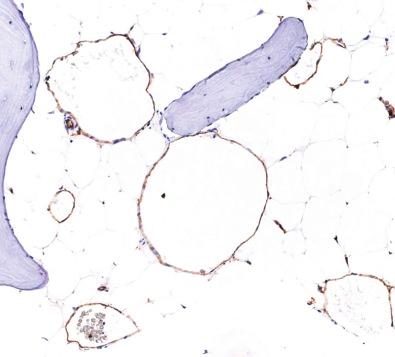
Recently, a single case report of a hemangioma documented the presence of a novel t(18; 22) (q23; q12) translocation resulting in a EWSR1-NFATC1 gene fusion. This is evidence that hemangiomas may be true neoplasms and not hamartomas or malformations, although this remains a point of controversy.
The differential diagnosis of conventional hemangioma includes lymphangioma and normal intraosseous vascular structures, and the distinction can be difficult in certain situations. Unlike hemangiomas, the vessels in lymphangioma often have irregular contours; the lumens may be filled with lymph fluid; and the endothelial cells express D2-40, Prox-1, and LYVE-1, in addition to the conventional endothelial markers. It should be noted that none of the lymphatic endothelial markers is entirely specific; therefore, the immunophenotype of a vascular tumor needs to be interpreted in the context of the morphology of the tumor and the clinical findings.
Sometimes, sections of the nutrient artery and its branches ( Fig. 13-12 ) are prominent in biopsy or resection specimens and thereby cause confusion with a hemangioma. Unlike the vessels of a hemangioma, however, the nutrient artery and its tributaries have prominent muscular walls, are limited in number, and do not grow in a diffuse pattern.
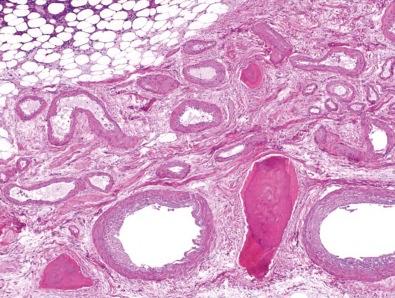
Lymphangioma is a benign vascular tumor composed of neoplastic endothelial cells that form lymphatic-like vessels. Its etiology and incidence are unknown; however, it is very rare and much less common than hemangioma. This may be related to the fact that normal bones do not have a lymphatic supply. The tumor can affect all age groups, although most present within the first two decades of life.
Lymphangioma may be solitary or multifocal and associated with lesions arising in the soft tissues. The tumor can develop in any bone, and most originate in the metaphysis or diaphysis of long bones, spine, and jaw. The presence or absence of symptoms depends on the anatomic site and extent of disease. The lesions can be asymptomatic, locally painful, or large masses that can cause pathologic fracture. Significant soft tissue involvement may be associated with lymphedema and swelling of an extremity. Chylous effusions may complicate lesions involving the chest wall.
Treatment depends on the extent of disease and associated symptoms. Bone lesions are usually effectively treated by curettage, and the recurrence rate is extremely low.
The findings vary based on size, extent, and multiplicity of the tumor. Solitary lesions are well demarcated, radiolucent, multiloculated, and may be expansile ( Fig. 13-13 ). On CT, the lesion is hypointense. On MRI, lymphangioma has increased signal on T1- and T2-weighted images. Multiple separate lesions can affect an individual bone or many bones throughout the skeleton.
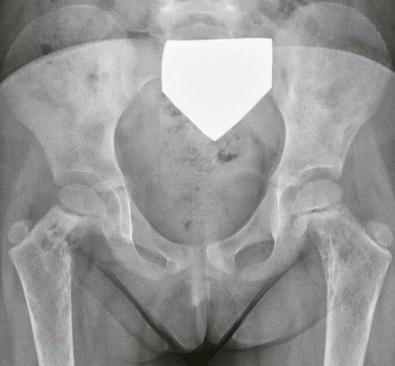
Grossly, lymphangioma is well circumscribed, honeycomb or cystic in appearance, and may contain clear or chylous fluid-filled spaces, divided by septa and thin bony trabeculae. This differs from hemangiomas, which are usually hemorrhagic in appearance.
Lymphangioma is composed of dilated, cystic channels that may contain valvelike structures and that are lined by flat, banal endothelial cells ( Fig. 13-14 ). The endothelial cells may appear to cover the surfaces of preexisting bony trabeculae or overlie a thin layer of woven bone. The cystic spaces can contain eosinophilic proteinaceous fluid and scattered red blood cells. Aggregates of lymphocytes are often found in the loose fibroconnective tissue surrounding the vessels. When the tumors contain numerous blood vessels, they may be difficult to distinguish from hemangioma.
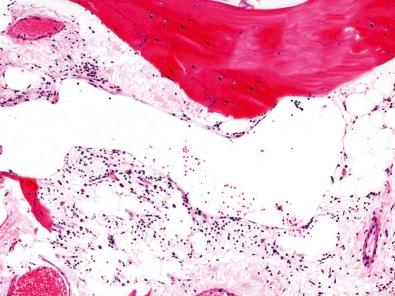
Similar to hemangiomas, lymphangiomas expresses CD31, CD34, factor VIII–related antigen, FLI1, and ERG. Prox-1, LYVE-1, and D2-40 are expressed by lymphatic endothelium, but they may also be expressed by endothelial cells in some hemangiomas; therefore, their specificity is limited ( Fig. 13-15 ).
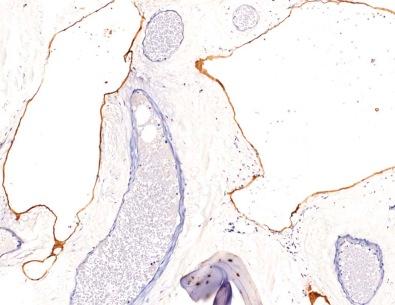
Lymphangioma can be difficult to diagnose in needle biopsy and curettage specimens because the vessel walls are delicate, thin, and easily disrupted. Helpful findings are long, thin, smooth strips of tissue that are lined by attenuated spindle cells. When the differential diagnosis is between lymphangioma and hemangioma, the presence of eosinophilic fluid and valvelike structures supports lymphangioma. Expression of Prox-1, LYVE-1, and D2-40 also provides further evidence of the nature of the lesion.
Skeletal angiomatosis is a multicentric disease composed of benign vascular tumors that involve multiple bones in one or more anatomic regions. The tumors may also affect the soft tissues and viscera. Synonyms include cystic angiomatosis of bone, lymphangiectasis of bone, Gorham disease, Gorham Stout disease, disappearing bone disease, phantom bone disease, and aggressive or massive osteolysis.
In this chapter, skeletal angiomatosis is classified into two major types. One, multiple discrete hemangiomas or lymphangiomas may involve one or more bones. Two, lymphangioma associated with extensive bone resorption may originate in one bone and progress to involve adjacent structures, cross joints, and invade articulating bones, eventually resulting in the loss of extensive amounts of bone, which leads to structural instability and potentially significant morbidity.
Patients may be asymptomatic or present with pain, pathologic fractures, and soft tissue masses (rarely). The tumors frequently arise in the bones of the axial skeleton and proximal extremities.
No proven etiology has been identified and there is no known familial predisposition. The age at diagnosis ranges from young children to the elderly, with a peak in the second to third decades of life, and the sexes are affected equally.
Treatment is based on symptomatology and, when necessary, usually entails surgical curettage or limited resection. The prognosis is usually good and only rarely does a hemangioma undergo malignant transformation into an angiosarcoma.
Gorham disease, first described in 1838 by Jackson, is more aggressive than the typical disease because it is associated with progressive bone resorption that may be extensive. The disease presents in young adults with no gender predisposition; common sites of involvement include the skull, jaw, extremities, shoulder and pelvic girdles, spine, and ribs. The location of the lesion determines the symptoms, which often include weakness, pain, and swelling. Chylous pericardial and pleural effusions can be seen when the pericardium or pleura are involved. Once the tumor forms, it induces resorption of the surrounding bone and continues to grow along the length of the bone and may cross joints into articulating bones and extend into the adjacent soft tissues and viscera. Numerous treatment modalities, including surgery, radiotherapy and medical therapy, have been used, often in combination. The goal is to halt progression of the disease therapy (bisphosphonates, thalidomide, and interferon) and then to resect the tumor with subsequent reconstruction to maintain structural stability. Recent studies have elucidated molecular pathways involved in the disease and have identified potential targets that can be treated with tyrosine kinase inhibitors and blockers of angiogenic growth factors. The prognosis is variable and depends on the location and severity of the disease. It can range from minimal disability to a fatal outcome (15% of patients) due to damage to vital organs such as the brainstem or spinal cord secondary to tumor involvement of neighboring supportive bones.
Radiographically, skeletal angiomatosis presents as multiple round to oval radiolucencies that have a honeycomb appearance and are well circumscribed (see Fig. 13-13 ). The lytic nature of the tumors on radiographs is what gave rise to the appellation “cystic.” The margins are sharp with variable degrees of sclerosis and endosteal scalloping. In some cases, the tumors are expansile and associated with soft tissue extension due to erosion of the cortex and involvement of adjacent structures.
Gorham disease first presents as poorly circumscribed intramedullary and cortical lucencies that merge and result in progressive dissolution, fracture, fragmentation, and complete disappearance of the involved bone ( Fig. 13-16 ). The adjacent soft tissues may undergo atrophy. In the early stages, the lesion may show increased uptake on bone scintigraphy, but subsequently the site of lost bone tissue shows decreased uptake. CT reveals loss of the bone substance, and the ends of the residual portions may have a pointed configuration. MRI shows that the involved bone demonstrates low signal intensity on T1-weighted images and increased signal intensity on T2-weighted images.
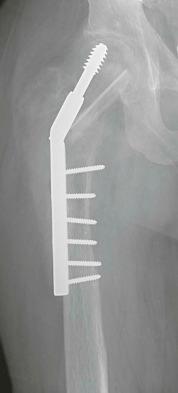
Become a Clinical Tree membership for Full access and enjoy Unlimited articles
If you are a member. Log in here